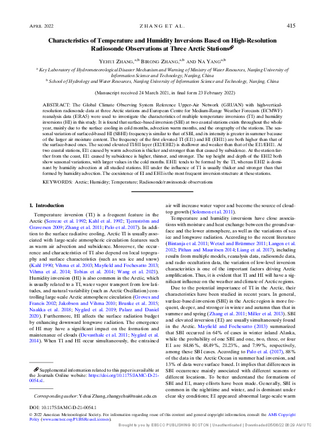The Global Climate Observing System Reference Upper-Air Network (GRUAN) with high-vertical-resolution radiosonde data at three Arctic stations and European Centre for Medium-Range Weather Forecasts (ECMWF) reanalysis data (ERA5) were used to investigate the characteristics of multiple temperature inversions (TI) and humidity inversions (HI) in this study. It is found that surface-based inversion (SBI) at two coastal stations exists throughout the whole year, mainly due to the surface cooling in cold months, advection warm months, and the orography of the stations. The seasonal variation of surfaced-based HI (SBHI) frequency is similar to that of SBI, and its intensity is greater in summer because of the larger air moisture content. The frequency of the first elevated TI (EI1) and HI (EHI1) are both higher than that of the surface-based ones. The second elevated TI/HI layer (EI2/EHI2) is shallower and weaker than that of the EI1/EHI1. At two coastal stations, EI1 caused by warm advection is thicker and stronger than that caused by subsidence. At the station farther from the coast, EI1 caused by subsidence is higher, thinner, and stronger. The top height and depth of the EHI2 both show seasonal variations, with larger values in the cold months. EHI1 tends to be formed by the TI, whereas EHI2 is dominant by humidity advection at all studied stations. HI under the influence of TI is usually thicker and stronger than that formed by humidity advection. The coexistence of EI and EHI is the most frequent inversion structure at these stations.
Title
Characteristics of Temperature and Humidity Inversions Based on High-Resolution Radiosonde Observations at Three Arctic Stations
Authors
Zhang, Y., Zhang, B., and Yang, N.
Published
by Journal of Applied Meteorology and Climatology (JAMC) at 2022-04-01
Abstract
